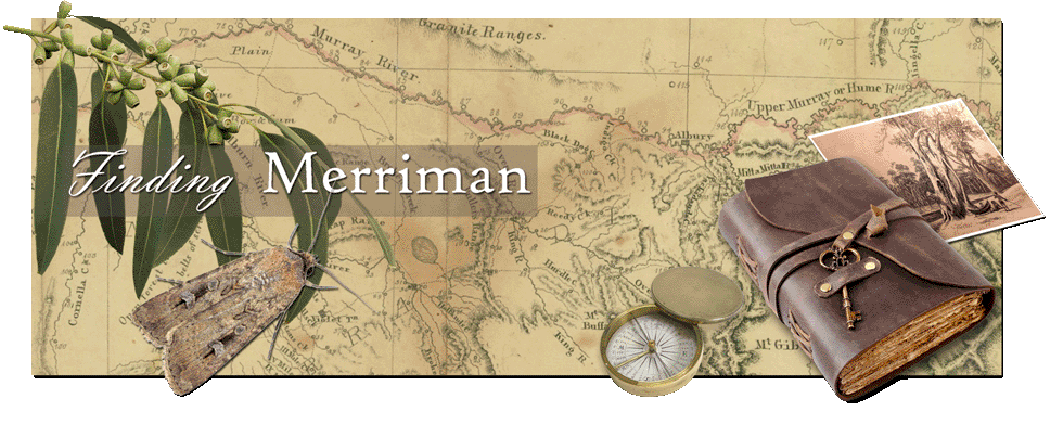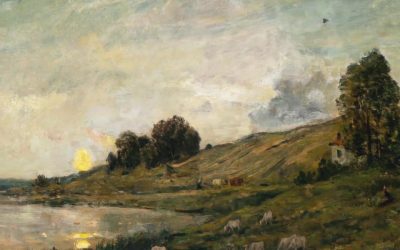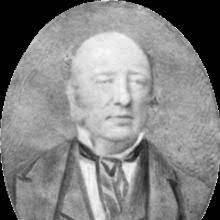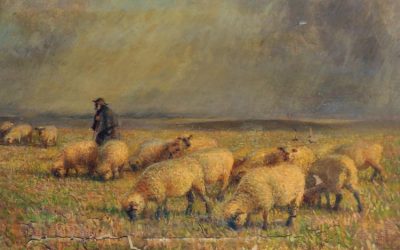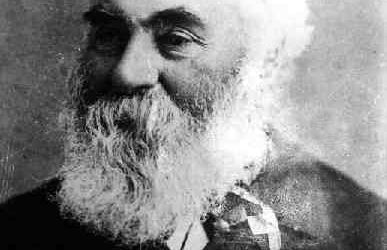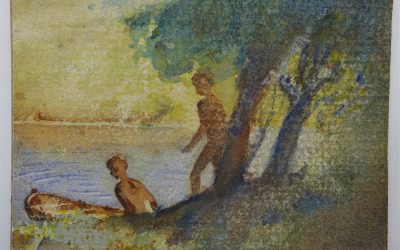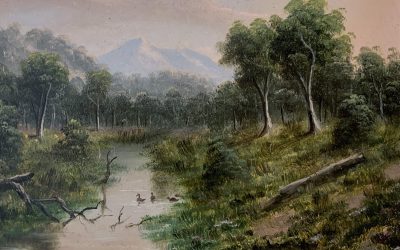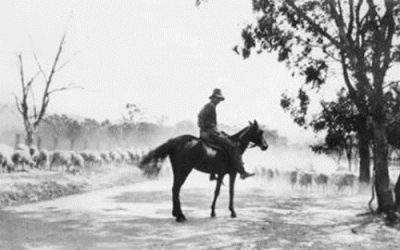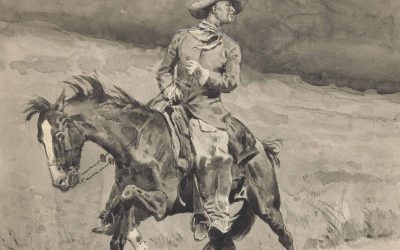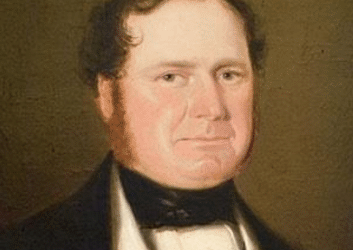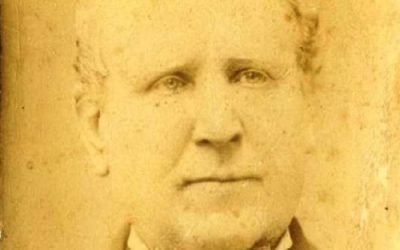WARNING: VISITORS TO THIS SITE SHOULD BE AWARE THAT THE FOLLOWING INFORMATION INCLUDES DISCUSSION OF DECEASED PEOPLE THAT MAY CAUSE SADNESS OR DISTRESS, PARTICULARLY TO ABORIGINAL AND TORRES STRAIT ISLANDER PEOPLE. IN PARTICULAR, I ACKNOWLEDGE THE ABORIGINAL ANCESTORS OF THE REGIONS OF WHICH I AM RESEARCHING, WHOSE WORDS MAY BE QUOTED AND PHOTOS INCLUDED WITH THE GREATEST RESPECT FOR THEIR LEGACY.
Who was Merriman
Merriman was accused of being a ring-leader of the Faithful massacre where eight shepherds were murdered at Benalla in 1838. History is not kind to him, it says he liked the taste of human flesh, killed his wife and was a troublemaker disrupting white settlement causing financial loss to the white men who came to his lands. (1)
However, these accounts were written through European eyes and no attempt was made to understand the reasons for these actions or investigate if Merriman was even guilty of the accusations.
When the first white men came to Merriman's lands he was 14 years old and intrigued by the strangers, their extraordinary animals and iron tools, he made himself invaluable to them. He became their friend, showing the white men where to plant crops and used his canoe to ferry goods across the flooded Murray River. (2)
There is evidence Merriman’s older brother Harlequin guided CH Ebden and AF Mollison to fertile lands near Mount Macedon where both men set up stations. (3)
But within a year or two, Merriman and Harlequin began to attack white settlers, raiding huts, killing men and animals and burning crops.
What happened to cause Merriman and his brother to change their opinion about the white men in their country?
Finding Merriman is the discovery of what happened 180 years ago through old journals, newspaper articles and historical records. It puts together the names of who laid claim to what land, identifying inciting events, the location and dates, identifying indigenous gathering places, axe quarries, places of ceremony and sacred places.
Merriman became an outlaw and although captured numerous times he was never brought to trial. His narrow escapes were ingenious and daring showing extraordinary athleticism and intellect.
The last recorded incident which mentions Merriman was in 1859 when he escaped police custody at Wangaratta. Merriman's life has never been researched before and the hope is we can set the record straight and untangle truth from fiction.
REFERENCES:
(1) AA Andrews, First Settlement of the Upper Murray
(2) The Journal of George Augustus Robinson, Chief Protector, Port Phillip Aboriginal Protectorate, 1839-1852 by Dr Ian D. Clark. pg 267, Tue 23rd Feb 1841
(3) An Overland Diary A.F. Mollison's of 1837, entry for November where Harlequin is mentioned
Why Is Merriman Important?
Merriman gives us insight into the early days of white settlement in North East Victoria. He was involved in pivotal moments such as the Faithful massacre and was one of the men Major Lettsom wanted to arrest in the shameful round up of 400 indigenous men, women and children who were marched at bayonet point to the Melbourne stockade in October 1840 when the city was in its infancy.
Merriman’s Waywurru lands included present-day Wangaratta, Benalla and Beechworth where overlanders were quick to set up stations on the valuable well-watered country - regardless that it was already occupied.
It was here that Merriman was the ringleader of the Whorouly siege demanding convict stockmen be made accountable for crimes against his people.
Finding Merriman gives insight into trade gatherings, travel outside tribal boundaries, care of country and the penalty for breaking the laws.
We have an account of Merriman enduring a payback as witnessed by Thomas Mitchell at Tangambalanga when Merriman stood before three armed men who threw spears simultaneously. Mitchell wrote of Merriman’s exceptional athleticism in walking away unscathed. (1)
In the siege at Dr George Mackays at Whorouly we find Merriman the instigator of a payback when he demanded the wife of convict stockman Benjamin Reed as payment for crimes committed. Reed was a known killer of Indigenous people and soon after had his ticket of leave revoked. (2)
Merriman was a highly intelligent, resourceful, athletic youth who lived at a time when the North East of Victoria was an Eden like paradise of rivers so clear you could see the fish, trees so tall five men with arms outstretched could barely encircle them and First Nations ruled supreme.
REFERENCES:
(1) AA Andrews, First Settlement of the Upper Murray,
(2) Brit Parli papers, pg 111, 112, 113. Statement of John Scobie Anderson Mackay to GA Robinson, 14th Feb 1841. Enc in No.25
Hams Squatting Map of Victoria (Port Phillip District) showing part of the Waywurru Nations Lands
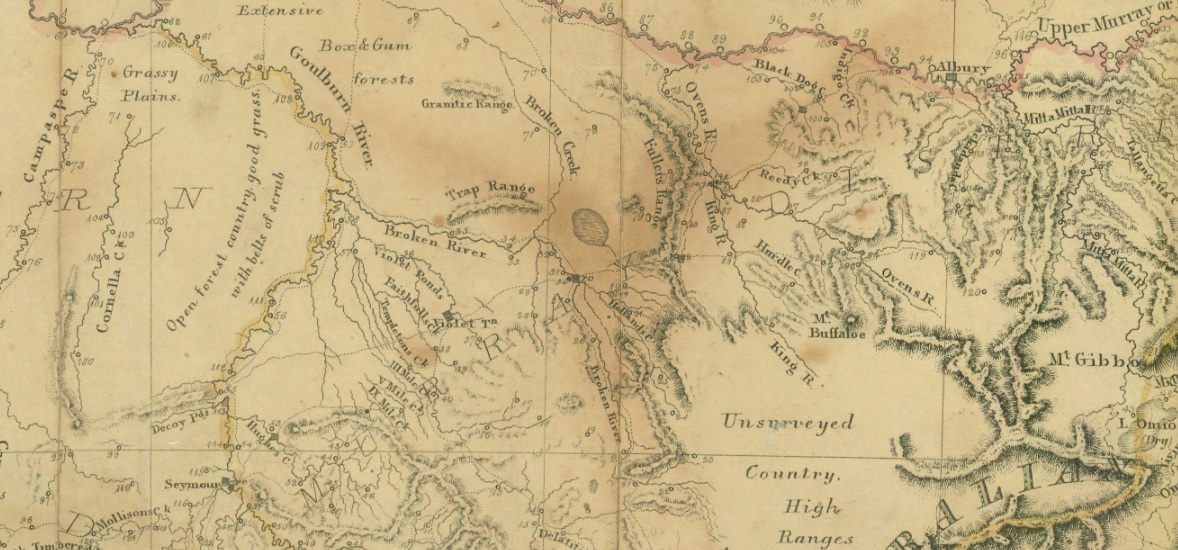
The Invasion Begins
In 1835 Charles Hotson Ebden sent his stockman William Wyse to the Murray to set up a station. Wyse set up camps on either side of the river where a natural ford offered easy access between the two. The first was at Mungabareena (Albury) the other was Bonegilla (near Wodonga). (1)
Mungabareena was a popular place for Indigenous people to camp and Oddies Creek at Albury's present-day Noreuil Park had fish traps and the sandhill in South Albury was a burial place. JFH Mitchell later wrote that he had seen one thousand Indigenous people attend the gathering at Mungabareena. Ebden and Wyse, having less than forty men between them would have found it imperative to make good relations with the Indigenous people. If they had done otherwise, they would not have survived.
This was the setting in which Merriman and his brother Harlequin came in contact with white men. Merriman’s knowledge of the area was used to advise the newcomers where to grow crops above flood level and Harlequin agreed to guide Ebden into Dja Dja Wurrung country where Ebden would form his Carlshrue station at Mount Macedon. (1)
In 1836 word spread of the fertile well-watered lands around the Murray River and overlanders began the arduous journey to an area considered ‘beyond the realms of civilisation’.
Old coves told the overlanding party's terrible stories about ‘savage Black cannibals’ which put great fear into the minds of the unarmed convict stockmen. Overlanding manager, Charles Bonney wrote of a stockman named Comerford so fearful of the Blacks he begged to be given a gun to defend himself. The weapon was later returned unused. But the fear of the unknown did not stop overlanders mustering animals and setting out to try their luck. (2)
Usually, the overlanding outfit was made up of a manager who was employed by a wealthy owner who stayed in Sydney. This appointed manager was often a middle-class youth in his early 20s newly arrived from England whose desire for adventure and success were the main requirements for the job. This manager usually had about 15 men, mostly assigned convicts for his use and one or two drays pulled by oxen to carry provisions to set up a station. They generally had sheep that numbered in the thousands and hundreds of head of cattle. The convict men had no choice in the venture and were known to abscond if conditions became difficult. The profile on Dignum and Comerford gives an idea of convict life while overlanding. (3)
Once the overlanding party reached the wilderness it was easy for the convict men to become unreliable resulting in sheep roaming unattended while the shepherds lazed or fraternized with indigenous women.
The goal for overlanding parties was to find suitable land for a station with fertile soil and reliable water and ideally, it would be ready to put the plough.
During those first few years, they found exactly what they were looking for due to Indigenous people’s methods of leaving open grasslands bounded by forests. These open areas were periodically burnt and within a few weeks, fresh green shoots would appear enticing prey to the area. There was no need to search for meat as it would be waiting in these open spaces. (4)
The first squatters compared these open areas to the great estates back in England where fine specimen trees provided shade amidst open grasslands. (5) Hume and Hovell noted in 1824 how these open grasslands north of Albury grew luxurious grasses so tall they reached the tops of their saddles as they rode by and at the Ovens Rivers, 'There are fine hills and grassland...as pretty a spot and as valuable as any I have seen since leaving home.' (6)
In 1837 a drought was making itself felt in NSW making feed and water-scarce so overlanding parties travelling down the Sydney road began to increase. The herds and flocks ate the grasses leaving nothing behind, subsequently, each party had to move further afield to find grass for their hungry animals. (7) To this end, overlanders sought land far back from the main road to avoid animals other than their own eating the grass and to lessen the risk of infection from catarrh (sheep flu) that was rampant in the colony and could see hundreds of sheep die with a few days.
In 1838 the traffic increased in either direction along the Sydney road and a weekly mail service between Melbourne and the Murray River was begun. A convict named John Conway Bourke was given the mail run and told by his employer, Joe Hawdon, that if he could complete it successfully for one year he would receive a pardon. JC Bourke was armed and on a tight schedule, he had no time to converse with the Indigenous people he came across and later spoke of some of these encounters having deadly consequences. (8)
The progress of white travellers along the Sydney road was largely tolerated by Indigenous people until April 1838 when WP Faithful’s shepherds were attacked on the Broken River at Benalla.
REFERENCES:
(1) AA Andrews, First Settlement of the Upper Murray
(2) Charles Bonney on TROVE https://nla.gov.au/nla.obj-360332043 Autobiographical notes
(3) See Profile on this website on Dignum & Comerford
(4) As told to me by Eddie Kneebone
(5) Bill Gamage, The Biggest Estate on Earth, Allen & Unwin
(6) Description of grasslands from Hume & Hovell, Journey of Discovery to Port Phillip, New South Wales in 1824 and 1825 by WH Hovell and H Hume.
(7) overlanders animals eating everything along the roadside, Lady Jane Franklin, Wed 24th April 1839. pg 70 This Errant Lady
(8) Letters written by John Conway Bourke held at The Royal Historical Society of Victoria, Melbourne. 1886-88
New Information
Faithful Massacre: The search to find Merriman has uncovered new information that raises questions suggesting the truth was not always told by squatters, their men nor the officials of the day. Commissioner for Crown lands 1837-39, EPS Sturt was camping near the Ovens River at the time of the Faithful massacre yet no statement from him has yet been found. One of the surviving shepherds made his way to Sturt's camp and alerted him of the attack. (1) CCL Sturt being the highest form of law and order in the land and military-trained would be expected to take charge. Yet there is no mention of him being present. (2)
In the days after the Faithful massacre, a reprisal killing was made upon Indigenous people on the King River not far from its junction with the Ovens River. A band of heavily armed squatters and their men, led by Peter Snodgrass wanted vengeance and took it. (3) How is it possible CCL Sturt did not know the squatters lusted for vengeance and do something to prevent it and where is his statement regards the Faithful massacre?
The cause of the Faithful Massacre of shepherds at the Broken River in April 1838 was officially considered to be over the theft of a lamb and the plunder of provisions but there is reason to believe it was caused by the shepherd's cruel treatment of Indigenous people. There is evidence the shepherds shot at Indigenous people at the Ovens River (4) and were intimate with Indigenous women (5).
WP Faithful confided in Lady Jane Franklin one year after the massacre that his shepherds had entered into a contest of skill with Indigenous people, pitting gun against spear. When the Blacks attacked Faithful's shepherds, the first man they speared was the shepherd who had the best aim with a gun. (6)
In statements taken after the massacre, the surviving shepherds spoke of finding bundles of spears in the days before the attack. (7) However, the night before the attack the shepherds mounted guard over a group of Blacks who slept at their camp. Why did Indigenous people sleep with the shepherds knowing they had lost the element of surprise? Eddie Kneebone, Bangerang man, artist and educator, believed the bundles of spears were a well known Black fellow signal that an attack would take place if payment of outstanding debts were not paid within three days. (8) Was the attack upon the shepherds because they refused payment?
One year after the attack upon Faithful's shepherds, Lady Jane Franklin stopped at the newly established police hut on the Broken River asked one of the constables if she and her party should be concerned of attack while they travelled through the area. The policeman assured her they were safe saying the Blacks would have seen them, ‘the whole way but they would not venture to attack as her party were too many….they will attack two or three but not five or six.’ (9) Why then, was WP Faithful's party which consisted of 18 shepherds attacked unless they had broken laws on Merriman's Waywurru lands and refused to pay compensation?
The Waterloo Plains Massacre was a killing of up to 23 Indigenous people accused of the theft of Bowman and Yaldwin's sheep in the winter of 1838. (10) But years later, John Coppock, the overseer for Yaldwin who led the massacre, wrote that in the weeks before the incident his convict servants were shooting at the local Indigenous people, killing men, women and children. (11)
Was the Waterloo Plains massacre over the theft of sheep or had the indiscriminate shooting of Indigenous people caused them to fight back? Officials never investigated this line of information and in the aftermath of the Waterloo Plains massacre, Bowman and Yaldwin both left the area. Bowman took his murderous ways (11.1) to Merriman's Waywurru lands at Tarrawingee (12) and Yaldwin left his Barfold station and went to Melbourne where he became a magistrate. (13)
Another piece of information that's come to light is that James Crossley, the overseer of WP Faithful's shepherds who were murdered at the Broken River had a connection with Benjamin Reed, a stockman belonging to William Bowman. Crossley and Reed arrived together in the colony on board the convict ship, Katherine Stewart Forbes. (14) On arrival, Crossley was assigned to WP Faithful and Benjamin Reed to William Bowman. Then by coincidence, they met up near Mt Macedon and together discovered the body of a missing servant assigned to WP Faithful. The servant, George Graham, appeared murdered by Blacks even though the search party expected to find him having succumbed to a malady of which he was prone. (15) Benjamin Reed, like his master, was a known killer of Indigenous people (11.1) and when he moved to Tarrawingee on the Ovens claimed he would, "shoot every bloody black on the river." (16)
Benjamin Reed was the cause of Merriman's siege at Dr George Mackay's Whorlouy station in May 1840. (17) Merriman's brother as well as other family members were killed and harassed in the aftermath. Major Lettsom rounded up 400 Indigenous people in Melbourne in the search for Merriman, killing Winberri and another man in the effort. However, the cause of the problem was Benjamin Reed and his punishment was having his ticket of leave revoked for a period of two years. (18)
REFERENCES:
(1) Letters of Victorian Pioneers – EPS Sturt, letter #49
(2) Historical Records of Victoria, Vol 2A, The Aborigines of Port Phillip 1835-1839, Chapter 12, Attacks on the Overland Routes to Port Phillip. pg 312 - 331
(3) Letters by John Conway Bourke, the mailman of 1838, held at Royal Historical Society Melbourne.
(4) Incident of WP Faithful's men shooting at Blacks on at the Ovens River is from, The North Eastern Ensign, Fri 30th August 1907. surviving shepherd William Mackay in conversation with his employer, John Bon of Wapin. Article titled ‘Further Information.’
(5) In 1883, Historian George Rusden wrote, ‘The men with the sheep quarrelled with the natives at the Broken River. The cause was the usual one. The convict men had trafficked with the women.’ History of Australia, vol. 2 pg 228. printed, 1883.
(6) Lady Jane Franklin, pg 100, 6th May 1839. WP Faithful speaks of gun against spear. This Errant Lady
(7) Statements of WP Faithful's men, Historical Records of Victoria, Vol 2A, The Aborigines of Port Phillip 1835-1839, Chapter 12, Attacks on the Overland Routes to Port Phillip. pg 312 - 331
(8) Information given to the author. Information on Eddie Kneebone
(9) Lady Jane Franklin, Entry for Monday 15th April 1839, pg 53 This Errant Lady
(10) colonial frontier massacres in Australia, Waterloo Plains Massacre
(11) John Coppock, “Old Time Memories: Trials and Experiences of a Pioneer,” “The Australasian,” 31 October 1885, courtesy of the National Library of Australia, Trove. John Coppock article
(11.1) Assistant Protector ES Parker’s report to Robinson, dated 20 June 1839, claimed that Bowman was in the habit of shooting every black man, woman or child whom he met on his run.
(12) AA Andrews, First Settlement of the Upper Murray, see William Bowman in the index and for further information on William Bowman please see his profile on this website.
(13) Information on William Henry Yaldwyn
(14) For more information on James Crossley and Benjamin Reed see their profiles on this website.
(15) Historical Records of Victoria, Vol 2A, The Aborigines of Port Phillip 1835-1839, Chapter 12, Attacks on the Overland Routes to Port Phillip. pg 334
(16) Brit Parli Papers, GA Robinson letter reporting Benjamin Reid as a killer of Indigenous people. Brit Parli Papers, Enclosure 2, in No. 25. Chief Protector’s Office, Melbourne; 27 February 1841, pg108
(17) Ogiers reminiscences of David Reid
(18) Benjamin Reid had his ticket of leave revoked and was returned to Hyde Park barracks. The charge against him was improper conduct. The Sydney Herald, Monday 9th August 1841, pg1. Two years later his ticket of leave was re-issued and he was free again.
Profiles
William & John Coghill
In early 1837 William Coghill was overlanding to...
William Henry Yaldwyn
could have prevented two massacres of Aboriginal...
Henry Munro
Henry Munro arrived in the colony in November...
George Hamilton
George Hamilton was in charge of Henry Howey's...
Merriman
Merriman was a Pallanganmiddang man of the...
William Bowman
Oil Painting by Alfred William Eustace, possibly...
James Crossley
James Crossley was the overseer in charge of WP...
Benjamin Reed
Benjamin Reed was a convict stockman assigned to...
Joseph Hawdon
Hawdon was born at Wackerfield, Durham, England...
William Pitt Faithful
Merriman was said to be one of the ring leaders...
John Conway Bourke
was born in Rathkeale, Limerick, Ireland 24th...
Charles Bonney
Charles Bonney was born on 31 October 1813 in...

